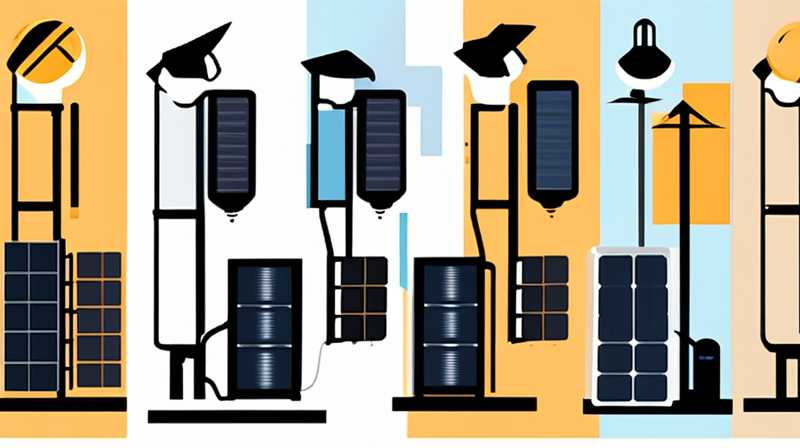
To effectively repair a solar street light, several essential steps need to be followed. 1. Assess the problem, 2. Check the solar panel, 3. Examine the battery, 4. Inspect the LED light and circuitry. A thorough evaluation of the issue is critical, as it helps to pinpoint the root cause of the malfunction and determines the most appropriate course of action.
1. ASSESSING THE PROBLEM
Understanding the specific issue at hand is fundamental to effectively repairing solar street lights. This entails a systematic approach to diagnosing any potential faults. One might begin by observing the light’s behavior at night; a light that does not turn on might signal a problem with the energy conversion system, while a flickering light could point towards issues with circuit integrity.
Diligent inspection should include physical evaluation of both the solar panel and the light unit. A damaged solar panel may not generate adequate power, while issues in wiring might disrupt the flow of electricity. Identifying whether the problem lies within the LED, battery, or photovoltaic system is vital for a comprehensive resolution.
2. CHECKING THE SOLAR PANEL
The solar panel is a critical component in a solar street light system, as it captures sunlight and converts it into electricity. Dirt, debris, or damage to the panel can significantly reduce its efficiency, leading to insufficient energy generation. Therefore, regularly cleaning the surface of the solar panel, as well as inspecting for cracks or physical damage, is crucial for maintaining optimal functionality.
If no visible damage is found, it is wise to measure the voltage output using a multimeter. This tool can provide insights into whether the solar panel is working effectively. A reading lower than expected might indicate an internal fault or blockage that requires immediate rectification. Proper maintenance ensures that the solar panel performs at its best, maximizing the energy input necessary for system operation.
3. EXAMINING THE BATTERY
The battery serves as the storage component within a solar street light system, holding energy for use during low sunlight conditions. Over time, batteries may degrade due to various factors, including age, environmental conditions, and improper charging cycles. Thus, monitoring battery health is an essential step in diagnosing system inefficiencies.
Visual inspection of the battery can yield insights into its condition. Look for signs of corrosion, leakage, or swelling. Utilizing a multimeter can help check for voltage stability and overall battery life. If the voltage is low or the battery does not hold charge, replacement may be necessary. It’s important to consider compatible batteries that match both the voltage and capacity requirements of the solar light system to prevent further complications.
4. INSPECTING THE LED LIGHT AND CIRCUITRY
The final critical element is the LED light and its connected circuitry. Malfunctions in the LED component, often due to power surges or physical damage, can lead to inadequate lighting, making it imperative to assess this component thoroughly. Start by checking connections, ensuring they are secure and free from corrosion or dirt.
For successful repairs, testing individual LED units might be necessary. If they are functional but not operating as expected, the circuitry may need evaluation. Inspect wiring for continuity, ensuring there are no breaks or shorts which could hinder performance. Resolving these electrical issues can restore functionality to the solar street light.
FAQs
WHAT ARE COMMON ISSUES WITH SOLAR STREET LIGHTS?
Several issues can affect solar street lights, including the malfunction of the solar panel, degradation or failure of the battery, and issues with the LED or wiring. Environmental factors like dust accumulation on panels and extreme weather conditions may also contribute to performance dips. Regular maintenance and assessment can help mitigate these problems.
HOW OFTEN SHOULD SOLAR STREET LIGHTS BE MAINTAINED?
Regular maintenance is recommended at least twice a year to ensure optimal performance. During maintenance, it is essential to clean the solar panels, check the battery, and inspect the LED components. In areas prone to heavy dust, rain, or snow, more frequent checks may be necessary to maintain functionality and avoid common issues.
CAN I REPLACE THE COMPONENTS MYSELF?
Yes, most solar street light components can be replaced independently, provided you have basic electrical knowledge and safety precautions in place. However, it is wise to consult the manufacturer’s guidelines before carrying out any replacements. If there are unfamiliar components, seeking professional assistance ensures safety and effective repair.
In summary, engaging in the systematic repair of solar street lights involves understanding issues clearly, checking solar panels, examining batteries, inspecting LED units, and ensuring circuit integrity. Regular monitoring and maintenance extend the lifetime and efficiency of solar street lights, allowing for reliable illumination and sustainability. By addressing each element systematically, the necessary repairs can be performed, enhancing the effectiveness of these eco-friendly lighting solutions. Whether it is routine maintenance or emergency repairs, knowledge of each component plays a vital role in ensuring solar-powered lighting continues to function reliably and efficiently.
Original article by NenPower, If reposted, please credit the source: https://nenpower.com/blog/how-to-repair-a-solar-street-light/


